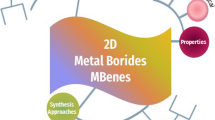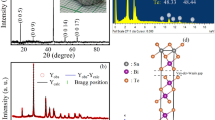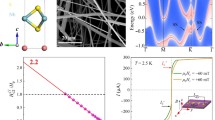Abstract
In this paper, by using the density functional theory, we have comprehensively investigated the magnetic properties of an armchair graphene nanoribbon (AGNR) passivated by hydrogen atoms and doped with transition metal elements such as Fe, Co and Mn in different substitution positions and various densities of impurity atoms. Magnetic properties such as spin polarization and magnetic moments of AGNR have been investigated versus the distance of dopants from the ribbon’s edge and the number of dopants. The results show that the values of spin band gap, spin polarization and magnetic moment can considerably vary depending on the type, position and the number of dopants. By comparing all three impurity atoms, we conclude that the substitution of the Mn instead of carbon produces higher magnetization than Fe and Co substitutions. Also, our results show that the spin filter efficiency of Mn-doped ribbon is higher those doped of Fe- and Co-doped. We expect that obtained results will have potential applications in spintronic devices.









Similar content being viewed by others
References
M. Terrones, A.R. Botello-Mendez, J. Campos-Delgado, F. Lopez-Urias, Y.I. Vega-Cantu, F.J. Rodriguez-Macias, A.L. Elias, E. Munoz-Sandoval, A.G. Cano-Marquez, J.C. Charlier, and H. Terrones, Graphene and graphite nanoribbons: morphology, properties, synthesis, defects and applications. Nano Today 5, 351–372 (2010).
S. Sehar, F. Sher, S. Zhang, U. Khalid, J. Sulejmanovic, and E.C. Lima, Thermodynamic and kinetic study of synthesised graphene oxide-CuO nanocomposites: a way forward to fuel additive and photocatalytic potentials. J. Mol. Liq. 313, 113494 (2020).
M. Javan, R. Jorjani, and A. Soltani, Theoretical study of nitrogen, boron, and co-doped (B, N) armchair graphene nanoribbons. J. Mol. Model. 26, 1–10 (2020).
J. Chen, Y. Hu, and H. Guo, First-principles analysis of photo-current in graphene PN Junctions. Phys. Rev. B 85, 155441 (2012).
K.S. Novoselov, A.K. Geim, S.V. Morozov, D. Jiang, Y. Zhang, S.V. Dubonos, I.V. Grigorieva, and A.A. Firsov, Electric field effect in atomically thin carbon films. Science 306, 666 (2004).
V. Nam Do and P. Dollfus, Negative differential resistance in zigzag-edge graphene nanoribbon junctions. J. Appl. Phys. 107, 063705 (2010).
Y. An, W. Ji, and Z. Yang, Z-like conducting pathways in zigzag graphene nanoribbons with edge protrusions. J. Phys. Chem. C 116, 5915–5919 (2012).
A. Hazra, R. Goswami, Carbon nanomaterial electronics: devices and applications, Adv. Sustain. Sci. Technol., 165-198 (2021).
N. Gorjizadeh, and Y. Kawazoe, Magnetic properties of Mn doped armchair graphene nanoribbon. Mater. Trans. 49, 2445–2447 (2008).
C. Cao, L.N. Chen, M.Q. Long, W.R. Huang, and X. Hui, Electronic transport properties on transition-metal terminated zigzag graphene nanoribbons. J. Appl. Phys. 111, 113708 (2012).
Y. Wang and H.P. Cheng, Interedge magnetic coupling in transition-metal terminated graphene nanoribbons. Phys. Rev. B 83, 113402 (2011).
M. Wu, X.C. Zeng and P. Jena, Unusual magnetic properties of functionalized graphene nanoribbons. J. Phys. Chem. Lett. 4, 2482–2488 (2013).
N.K. Jaiswal and P. Srivastava, Fe-doped armchair graphene nanoribbons for spintronic/interconnect applications. IEEE Trans. Nanotechnol. 12, 685–691 (2013).
B. Li, D. Xu, J. Zhao, H. Zeng, First principles study of electronic and magnetic properties of co-doped armchair graphene nanoribbons, J. Nanomater. (2015).
Y. Yu-E, Y. Xiao, X.H. Yan, and C.J. Dai, Transport properties of zigzag graphene nanoribbons adsorbed with single iron atom. Chin. Phys. B 24, 117204 (2015).
N. Tyagi, N.K. Jaiswal, K.K. Jha, V. Sharma, and P. Srivastava, Structural, magnetic and electronic properties of armchair graphene nanoribbons interacting with Co: DFT investigations. Ferroelectrics 519, 178–186 (2017).
O. Omeroglu, E. Kutlu, P. Narin, S.B. Lisesivdin, and E. Ozbay, Electronic properties of graphene nanoribbons doped with zinc, cadmium, mercury atoms. Physica E 104, 124–129 (2018).
D.J. Adams, O. Gröning, C.A. Pignedoli, P. Ruffieux, R. Fasel, and D. Passerone, Stable ferromagnetism and doping-induced half-metallicity in asymmetric graphene nanoribbons. Phys. Rev. B 85, 245405 (2012).
D.W. Boukhvalov and M.I. Katsnelson, Chemical functionalization of graphene with defects. Nano Lett. 8, 4373–4379 (2008).
J. Jung and A.H. MacDonald, Magnetoelectric coupling in zigzag graphene nanoribbons. Phys. Rev. B 81, 195408 (2010).
Y.L. Lee, S. Kim, C. Park, J. Ihm, and Y.W. Son, Controlling half-metallicity of graphene nanoribbons by using a ferroelectric polymer. ACS Nano 4, 1345–1350 (2010).
J. Zhou, T. Hu, J.M. Dong, and Y. Kawazoe, Ferromagnetism in a graphene nanoribbon with grain boundary defects. Phys. Rev. B 86, 035434 (2012).
B. Huang, Electronic properties of boron and nitrogen doped graphene nanoribbons and its application for graphene electronics. Phys Lett A. 375, 845–848 (2011).
S. Varghese, S. Swaminathan, K. Singh, and V. Mittal, Energetic stabilities, structural and electronic properties of monolayer graphene doped with boron and nitrogen atoms. Electronics 5, 91 (2016).
D. Zhang, M. Long, X. Zhang, F. Ouyang, M. Li, and H. Xu, Designing of spin-filtering devices in zigzag graphene nanoribbons heterojunctions by asymmetric hydrogenation and B-N doping. J. Appl. Phys. 117, 014311 (2015).
T. Movlarooy, and P. Zanganeh, Spin transport properties of armchair graphene nanoribbons doped with Fe and B atoms. Mater. Sci. B 243, 167–174 (2019).
F. Lopez-Urias, J.L. Fajardo-DiAZ, A.J. Cortes-Lopez, C.L. Rodriguez-Corvera, L.E. Jimenez-Ramirez, and E. Munoz-Sandoval, Spin-dependent band-gap driven by nitrogen and oxygen functional groups in zigzag graphene nanoribbons. Appl. Surf. Sci. 521, 146435 (2020).
F. Lopez-Urias, A.D. Martinez-Iniesta, A. Morelos-Gomez, and E. Munoz-Sandoval, Tuning the electronic and magnetic properties of graphene nanoribbons through phosphorus doping and functionalization. Mater. Chem. Phys. 265, 124450 (2021).
C. Chen, Z. Zhu, D. Zha, M. Qi, and J. Wu, The magnetic and transport properties of edge passivated silicenenanoribbon by Mn atoms. Chem. Phys. Lett. 646, 148–152 (2016).
C. Guo, T. Wang, C. Xia, and Y. Liu, Modulation of electronic transport properties in armchair phosphorene nanoribbons by doping and edge passivation. Sci. Rep. 7, 12799 (2017).
N. Liu, H. Zhu, Y. Feng, S. Zhu, K. Yao, and S. Wang, Tuning of the electronic structures and spin-dependent transport properties of phosphorene nanoribbons by vanadium substitutional doping. Phys. E Low-dimens. Syst. Nanostruct. 138, 115067 (2022).
Y.W. Son, M.L. Cohen, and S.G. Louire, Energy gaps in graphene nanoribbons. Phys. Rev. Lett. 97, 216803 (2006).
M.Y. Han, B. Özyilmaz, Y. Zhang, and P. Kim, Energy band-gap engineering of graphene nanoribbons. Phys. Rev. Lett. 98, 206805 (2007).
V. Barone, O. Hod, and G.E. Scuseria, Electronic structure and stability of semiconducting graphene nanoribbons. Nano Lett. 6, 2748 (2006).
N.K. Jaiswal and P. Srivastava, Enhanced metallicity and spin polarization in zigzag graphene nanoribbons with Fe impurities. Physica E. 54, 103–108 (2013).
S. Chakrabarty, A.H.M. Abdul Wasey, R. Thap, and G.P. Dasa, Origin of spin polarization in edge boron doped zigzag graphene nanoribbon: a potential spin filter. Nanotechnology 29, 345203 (2018).
Author information
Authors and Affiliations
Corresponding author
Ethics declarations
Conflict of interest
The authors declare that they have no conflict of interest.
Ethical Approval
This study did not involve human participants, their data or biological material.
Additional information
Publisher's Note
Springer Nature remains neutral with regard to jurisdictional claims in published maps and institutional affiliations.
Rights and permissions
About this article
Cite this article
Allahverdikhani, T., Barvestani, J. & Meshginqalam, B. Theoretical Investigation of the Effect of Different Dopants and Their Positions on the Magnetic Properties of an Armchair Graphene Nanoribbon. J. Electron. Mater. 51, 2900–2908 (2022). https://doi.org/10.1007/s11664-022-09574-y
Received:
Accepted:
Published:
Issue Date:
DOI: https://doi.org/10.1007/s11664-022-09574-y




